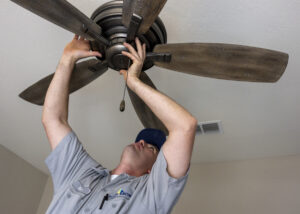How Much Energy Do Ceiling Fans Use
I don’t know about you, but when my electric bill arrives and it’s higher than expected, I start eyeing every appliance in my house with suspicion. That ceiling fan whirring away overhead? It’s definitely on the list of potential energy vampires.
But here’s the thing – ceiling fans don’t waste much electricity at all, provided you’re using them correctly. In fact, they can be one of your best allies in keeping energy costs down. Let me walk you through what I’ve learned about these surprisingly efficient household helpers.
The Real Numbers: How Much Power Do Fans Use?
Let’s get straight to the facts. Your typical ceiling fan only uses between 15 to 90 watts per hour, depending on its size and the speed setting you’ve got it on. To put that in perspective, your air conditioner is probably guzzling between 1,000 to 3,500 watts per hour. That’s a massive difference!
Here’s what this means for your wallet:
- If you run a 75-watt ceiling fan for 8 hours a day, you’re using about 600 watt-hours (or 0.6 kilowatt-hours) of electricity.
- With the national average electricity cost hovering around 15 cents per kilowatt-hour, that’s less than a dime a day to run your fan.
- Run it every day for a month? You’re looking at roughly $2.50 to $3.00 on your electric bill.
That’s incredibly cheap cooling—especially if using that fan lets you set your thermostat a few degrees higher in the summer.
The Ceiling Fan Misconception Most People Don’t Realize
Here’s where things get interesting (and where many of us waste energy without realizing it): ceiling fans don’t cool rooms—they cool people.
Wait, what? That’s right. Fans don’t lower the air temperature one bit. What they do is create airflow that helps sweat evaporate from your skin faster, which makes you feel cooler through a process called evaporative cooling. It’s the same principle that makes a breeze feel refreshing on a hot day.
This leads us to the golden rule of ceiling fan efficiency: if nobody’s in the room to feel the breeze, running the fan is 100% wasted electricity. Unlike your AC or heater, which change the actual temperature in a space, fans only create a cooling sensation for the people directly experiencing the airflow.
This is where the real waste happens—not because ceiling fans themselves are energy hogs, but because we leave them spinning in empty rooms, cooling absolutely nobody.
How to Use Ceiling Fans the Smart Way
Now that we understand how fans work, let’s talk about using them strategically to maximize comfort while minimizing your energy bills:
Team Up Your Fan With AC
Use both together, but with a twist. Set your thermostat 2–4 degrees higher than you normally would, then let the ceiling fan create that cooling sensation. Your AC will run less frequently, saving significant energy while you stay just as comfortable.
I tried this approach last summer and was amazed how comfortable my home felt with the thermostat set at 78 instead of my usual 74. The fan made all the difference, and my electric bill showed it.
The Empty Room Rule
I know I’m repeating myself, but this is worth emphasizing: turn fans off when you leave the room. Your couch doesn’t need cooling, and your houseplants certainly don’t care about the breeze.
Make it a habit—just like flipping off the light switch when you exit a room. Your future electric bill will thank you.
Seasonal Direction Switch
Did you know that your ceiling fan should rotate in different directions depending on the season? In summer, your fan should spin counterclockwise to push air downward, creating that cooling breeze.
In winter, flip the small switch on the fan housing to make the blades rotate clockwise at a low speed. This pulls cool air up and gently pushes the warm air that naturally collects at the ceiling back down into the living space—without creating a chilly draft. It’s a game-changer for winter comfort!
Consider an Upgrade
If your ceiling fan is more than 10 years old, you might be surprised at how much more efficient newer models are. Modern ENERGY STAR® certified fans can use up to 30% less energy while moving more air.
Plus, newer fans often come with better motors, improved blade designs, and integrated LED lighting that further reduces energy consumption. When you consider that you’ll be using it for years to come, the upgrade can pay for itself surprisingly quickly.
When Something’s Not Right With Your Fan
Sometimes, energy waste isn’t about how you use your fan—it’s about the fan itself. Here are some signs that your ceiling fan might need professional attention:
- It wobbles or makes clicking, scraping, or grinding noises
- The motor hums loudly but the blades barely move
- You notice it’s unusually warm to the touch after running
- Your electric bills seem higher than they should be for the usage
- It only works on certain speeds or sometimes doesn’t start at all
These symptoms could indicate electrical problems, bearing issues, or imbalance—all of which can cause your fan to draw more power than it should while delivering less airflow. In these cases, a repair or replacement might save you money in the long run.
Common Questions People Ask About Ceiling Fans
If fans don’t cool rooms, should I bother using them when I’m not home to pre-cool the space?
Nope! Unlike an AC that you might run before coming home on a hot day, there’s absolutely no benefit to running a ceiling fan in an empty house. It doesn’t change the room temperature at all.
Do ceiling fans help in winter too?
Absolutely! With the direction switched to clockwise and run at low speed, ceiling fans help redistribute the warm air that naturally rises to the ceiling. This can make your heating system more efficient by ensuring the warmth reaches you instead of just hanging out up high.
My ceiling fan has a light kit. Does that use a lot of power?
It depends on the bulbs. If your fan still has older incandescent bulbs, switching to LEDs can cut the lighting energy use by up to 80%. Many newer fan models come with integrated LED lights that use minimal electricity.
How long should a ceiling fan last before it starts wasting energy?
A quality ceiling fan should run efficiently for about 10-15 years with proper care. After that, you might notice decreased performance and potentially increased energy consumption. If your fan is approaching this age range, it’s worth considering whether an upgrade might save you money.
The Bottom Line: Fans Are Friends (When Used Wisely)
Ceiling fans don’t waste electricity, inefficient use of ceiling fans does. When used strategically, these simple devices can significantly reduce your cooling costs while improving your comfort year-round.
Remember, fans cool people, not rooms. Use them when you’re present, switch them off when you leave, adjust their direction seasonally, and keep them well-maintained. Follow these simple rules, and your ceiling fan will remain one of the most energy-efficient comfort tools in your home.
